Community-led regeneration approach: review
Findings from an independent review into the partnership approach delivered by the People and Communities Fund (PCF).
4. Project Co-production Approaches
Introduction
This Chapter presents five models of how Community Anchors addressed co-production in their community engagement approaches. The models were identified and designed by the study team following the research of the12 projects. As such, the observations of the researchers with regard to how the Community Anchors engaged with their communities and target groups, and how their activities involved other partner organisations informed the design of five models. The models, therefore, are research findings in their own right and seek to differentiate the various co-production approaches used by the Community Anchor organisations.
The PCF approach to community-led regeneration operates in a multi issue environment, thereby supporting a wide range of community organisations, themes, and target groups. This influences the way in which projects engage with their communities. Reflecting this context, the study was able to identify a number of approaches in which the Community Anchors implemented their PCF funded activities.
The following presents five models highlighting the multi-dimensional approach of the Programme/Community Anchors and their ability to adapt to different local environments, project topics and target groups.
The Models are numbered merely for the purpose of identification and we are not suggesting that one model is necessairly better than any other. Community organisations need to respond to different circumstances and environments which determines the kind of co-production that can be implemented.
The projects have been allocated to their respective models, yet it should be noted that in reality, overlaps exist between the approaches.
Case studies have been produced for each model and are available in a separate document.
Understanding Co-production
Integral to our research approach was to acknowledge the underlying core principles of PCF associated with community-led regeneration, which are community engagement, co-production, and co-delivery.
The definitions of the terms overlap to some extent and although the PCF programme documentation primarily refers to 'community engagement', it was agreed to use the term 'co-production [3] ' as set out by six guiding principles:
- Recognise people as assets;
- Build on existing capabilities;
- Mutuality and reciprocity;
- Peer support networks;
- Break down barriers; and
- Facilitate rather than deliver.
Figure 4.1 was also used to inform the design of some of the primary research material (Development Ladders) focusing on exploring the extent to which PCF stakeholders are applying a co-production approach.
Figure 4.1: Co-production Process
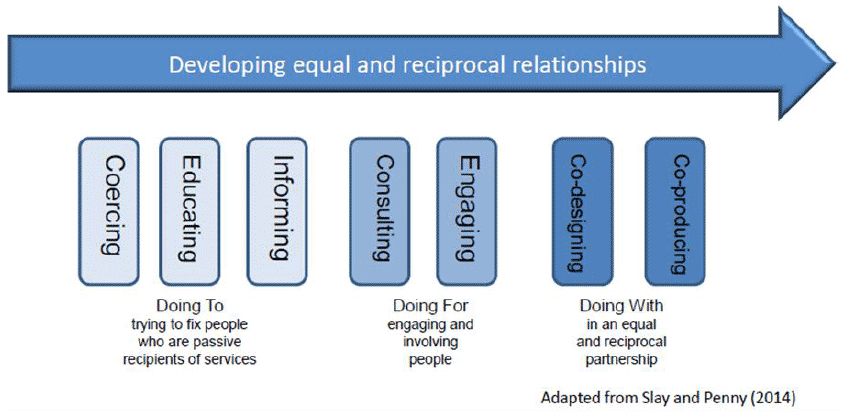
The Scottish Government's Regeneration Strategy ' Achieving a Sustainable Future ' places support for community-led regeneration at the heart of its approach, recognising that the changes required to make all communities sustainable will only be achieved when communities themselves play a part in delivering change. The Scottish Government breifing also recognised that there are different levels and types of involvement represented by the range of dynamics between actors; moving from 'doing to', to 'doing for' and ultimately 'doing with'.
Co-production Models
Co-production Model 1: Traditional, Integrated Service Delivery
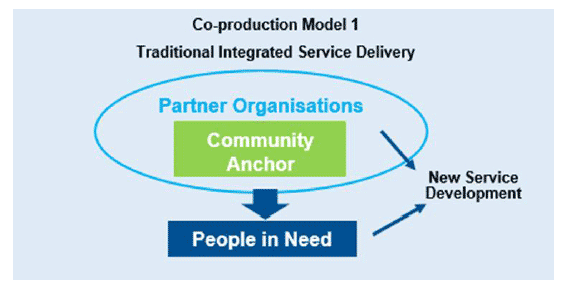
Model 1 describes a co-production approach which focuses on providing services to a particular target group in need of specific services, such as financial advice or improved access to local services. Most projects used the service provision (in many cases delivered by volunteers) to find out what other needs the beneficiaries have in order to develop new initiatives.
The role of partner organisations (at strategic level, or other service providers) is usually to signpost/refer beneficiaries to the project and vice versa.
Projects which are closest to Model 1 include:
- The Falkirk Advice Project
- Helping Hands;
- Horshader Rural Support and Connect project; and
- Growing Gardeners.
Co-production Model 2: Focus on Employability and Skills Development
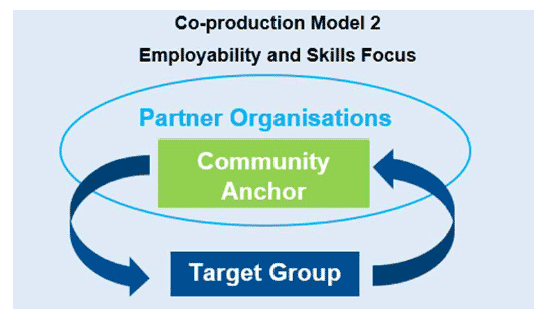
Model 2 engages with the target group beneficiaries more actively, by involving them in work placements and other training initiatives. The focus is on developing the skills sets of the target group individuals (which also includes volunteer development).
Usually, the recipients of the training are placed within the Community Anchor organisation or with other partner organisations.
The role of the partner organisations is to signpost/refer suitable candidates for the training/work placement and/or provide work placements in their organisation.
Projects which are closest to Model 2 include:
- EHRA Modern Housing Apprenticeships; and
- Volunteer Development.
Co-production Model 3: Two Level Engagement
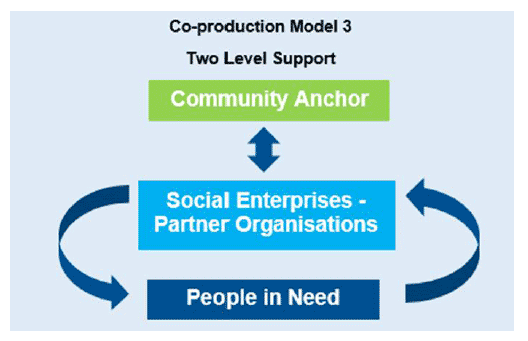
In Model 3, the partner organisations take on a more central role in the delivery of the project, involving them not only in providing work placements, but also in in-depth development support due to the multi-level needs of the specific target group.
PCF support worked at two levels, (1) through partner organisations gaining capacity and fulfilling their social policy remit, and (2) by supporting beneficiaries to gain employability and life skills.
PCF funding supported work placements in social enterprises (partner organisations) tapping into the social focus and nurturing environment of the social enterprise rationale in view of the multiple needs of the beneficiaries. The support benefits the beneficiaries as well as the social enterprises.
Projects which are closest to Model 3 include:
- Inspiring Locally Grown Employability in Argyll.
Co-production Model 4: Social Inclusion and Employability Progression
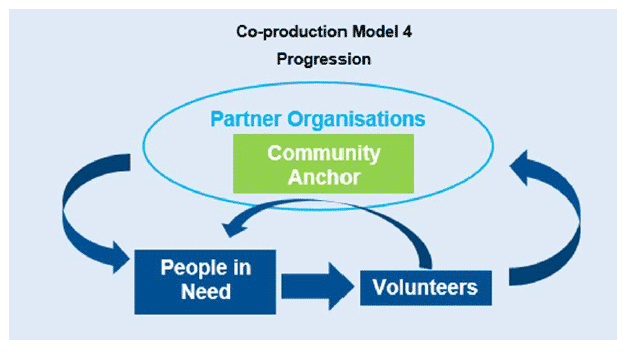
In Model 4, the Community Anchor delivers services ( e.g. food, advice) to beneficiaries in need and further engages them through a diversity of other activities to help them progress in their personal and employability development. Here, a particular focus is to encourage service users to become volunteers in the Community Anchor as part of their employability skills development.
The volunteers (previous service users themselves) will then engage directly with the next cohort of service users. In many projects, this progression has led previous service users to succesful employment or start up of their own social enterprise.
Projects which are closest to Model 4 include:
- AHEAD+;
- 20 More;
- Mentoring Transition Support Service; and
- Pathways to Learning.
Co-production Model 5: Double level integrated progression model
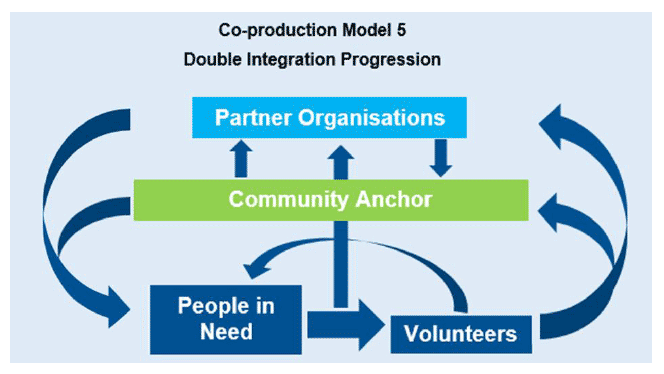
Model 5 represents both Model 3 and 4 combined. Alongside delivering a diverse range of support services to the beneficiary groups, the Community Anchor maintains strong links with other strategic and local organisations.
The partner organisations offer work placements, volunteering places and have a strong self-interest in working with the Community Anchor through which they are enabled themselves to reach and work with the target groups (for example, to implement their Corporate Social Responsibilities policies or service improvement targets regarding social inclusion).
At the same time, the beneficiaries are progressing from service user to volunteer positions within the Community Anchor to progress their skills attainment, delivering mentoring to new service users, and progressing to employment or starting up their own social enterprise.
Projects which are closest to Model 5 include:
- Inspiring Transformation
Contact
There is a problem
Thanks for your feedback